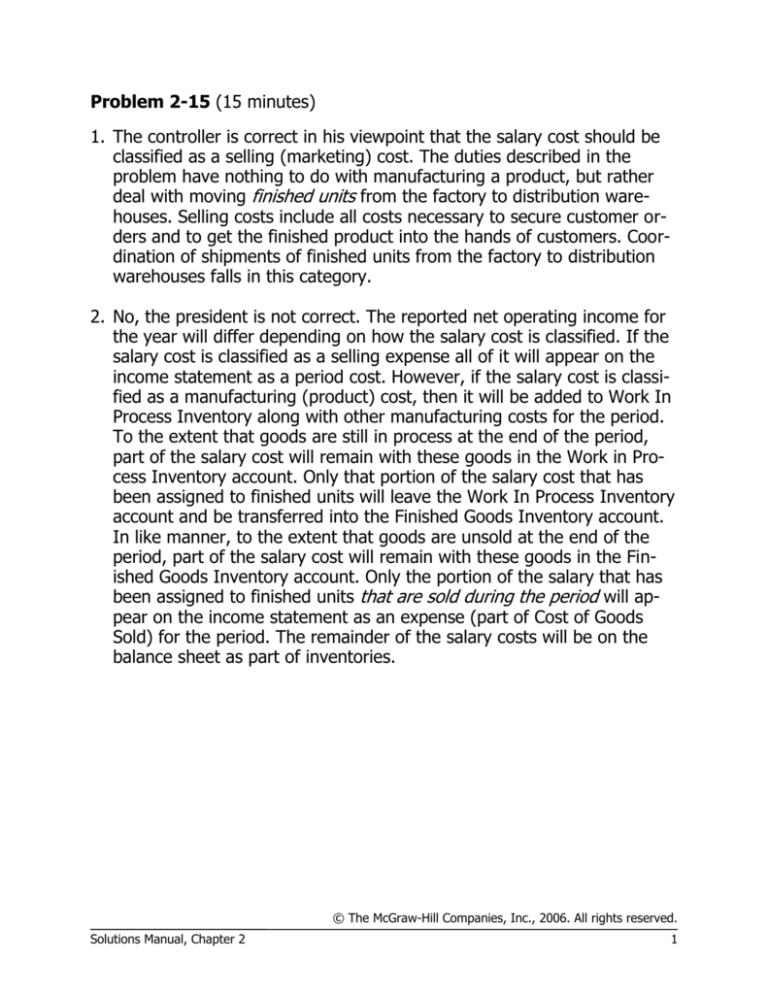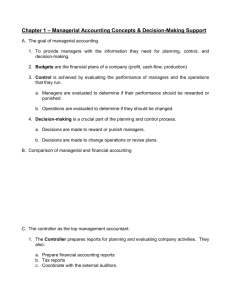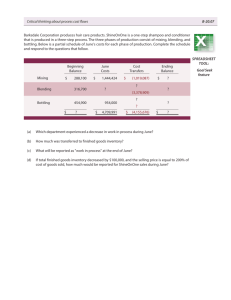
Problem 2-15 (15 minutes)
1. The controller is correct in his viewpoint that the salary cost should be
classified as a selling (marketing) cost. The duties described in the
problem have nothing to do with manufacturing a product, but rather
deal with moving finished units from the factory to distribution warehouses. Selling costs include all costs necessary to secure customer orders and to get the finished product into the hands of customers. Coordination of shipments of finished units from the factory to distribution
warehouses falls in this category.
2. No, the president is not correct. The reported net operating income for
the year will differ depending on how the salary cost is classified. If the
salary cost is classified as a selling expense all of it will appear on the
income statement as a period cost. However, if the salary cost is classified as a manufacturing (product) cost, then it will be added to Work In
Process Inventory along with other manufacturing costs for the period.
To the extent that goods are still in process at the end of the period,
part of the salary cost will remain with these goods in the Work in Process Inventory account. Only that portion of the salary cost that has
been assigned to finished units will leave the Work In Process Inventory
account and be transferred into the Finished Goods Inventory account.
In like manner, to the extent that goods are unsold at the end of the
period, part of the salary cost will remain with these goods in the Finished Goods Inventory account. Only the portion of the salary that has
been assigned to finished units that are sold during the period will appear on the income statement as an expense (part of Cost of Goods
Sold) for the period. The remainder of the salary costs will be on the
balance sheet as part of inventories.
© The McGraw-Hill Companies, Inc., 2006. All rights reserved.
Solutions Manual, Chapter 2
1
Problem 2-16 (30 minutes)
Note to the Instructor: There may be some exceptions to the answers below. The purpose of this problem is to get the student to start thinking about cost behavior and cost purposes; therefore, try to avoid
lengthy discussions about how a particular cost is classified.
Cost Item
1. Property taxes, factory .................................
2. Boxes used for packaging detergent produced by the company...............................
3. Salespersons’ commissions ...........................
4. Supervisor’s salary, factory ...........................
5. Depreciation, executive autos .......................
6. Wages of workers assembling computers ......
7. Insurance, finished goods warehouses ..........
8. Lubricants for machines................................
9. Advertising costs ..........................................
10. Microchips used in producing calculators .......
11. Shipping costs on merchandise sold ..............
12. Magazine subscriptions, factory lunchroom ....
13. Thread in a garment factory .........................
14. Billing costs .................................................
15. Executive life insurance ................................
Variable or Selling
Fixed
Cost
F
V
V
F
F
V
F
V
F
V
V
F
V
V
F
Administrative
Cost
Manufacturing
(Product) Cost
Direct Indirect
X
X
X
X
X
X
X
X
X
X
X
X
X
X*
X
© The McGraw-Hill Companies, Inc., 2006. All rights reserved.
2
Managerial Accounting, 11th Edition
Problem 2-16 (continued)
16.
17.
18.
19.
Cost Item
Ink used in textbook production....................
Fringe benefits, assembly-line workers ..........
Yarn used in sweater production ...................
Wages of receptionist, executive offices ........
Variable or Selling
Fixed
Cost
V
V
V
F
Administrative
Cost
* Could be administrative cost.
** Could be indirect cost.
© The McGraw-Hill Companies, Inc., 2006. All rights reserved.
3
Managerial Accounting, 11th Edition
Manufacturing
(Product) Cost
Direct Indirect
X
X**
X
X
Problem 2-19 (45 minutes)
Case 1
Case 2
Case 3
Case 4
Direct materials ................ $ 4,500
$ 6,000
$ 5,000
$ 3,000
Direct labor ......................
9,000 *
3,000
7,000
4,000
Manufacturing overhead....
5,000
4,000
8,000 * 9,000
Total manufacturing costs . 18,500
13,000 * 20,000
16,000 *
Beginning work in process
inventory .......................
2,500
2,000 * 3,000
4,500 *
Ending work in process
inventory .......................
(3,000) *
(1,000)
(4,000)
(3,000)
Cost of goods manufactured ............................. $18,000
$14,000
$19,000 * $17,500
Sales ................................ $30,000
$21,000
$36,000
$40,000
Beginning finished goods
inventory .......................
1,000
2,500
3,500 * 2,000
Cost of goods manufactured ............................. 18,000
14,000
19,000 * 17,500
Goods available for sale .... 19,000 * 16,500 * 22,500 * 19,500
Ending finished goods inventory ..........................
(2,000) *
(1,500)
(4,000)
(3,500)
Cost of goods sold ............ 17,000
15,000 * 18,500
16,000
Gross margin .................... 13,000
6,000 * 17,500
24,000
Operating expenses ..........
(9,000) *
(3,500) (12,500) * (15,000)
Net operating income........ $ 4,000
$ 2,500 * $ 5,000
$ 9,000
* Missing data in the problem.
*
*
*
*
© The McGraw-Hill Companies, Inc., 2006. All rights reserved.
4
Managerial Accounting, 11th Edition
Problem 2-27 (60 minutes)
1.
Visic Corporation
Schedule of Cost of Goods Manufactured
Direct materials:
Raw materials inventory, beginning ....................... $ 20,000
Add: Purchases of raw materials ............................ 480,000
Raw materials available for use ............................. 500,000
Deduct: Raw materials inventory, ending ............... 30,000
Raw materials used in production ..........................
$470,000
Direct labor .............................................................
90,000
Manufacturing overhead:
Indirect labor ....................................................... 85,000
Building rent (80% × $40,000) ............................ 32,000
Utilities, factory .................................................... 108,000
Royalty on patent ($1.50 per unit × 29,000 units) .. 43,500
Maintenance, factory ............................................
9,000
Rent on equipment
15,700
$7,000 + ($0.30 per unit × 29,000 units) ...........
Other factory overhead costs ................................
6,800
Total overhead costs ...............................................
300,000
Total manufacturing costs........................................
860,000
Add: Work in process inventory, beginning ...............
50,000
910,000
Deduct: Work in process inventory, ending ...............
40,000
Cost of goods manufactured ....................................
$870,000
© The McGraw-Hill Companies, Inc., 2006. All rights reserved.
Solutions Manual, Chapter 2
5
Problem 2-27 (continued)
2. a. To compute the number of units in the finished goods inventory at
the end of the year, we must first compute the number of units sold
during the year.
Total sales
$1,300,000
=
= 26,000 units sold
Unit selling price
$50 per unit sold
Units
Units
Units
Units
Units
in the finished goods inventory, beginning ....
produced during the year .............................
available for sale ..........................................
sold during the year (above) .......................
in the finished goods inventory, ending .........
0
29,000
29,000
26,000
3,000
b. The average production cost per unit during the year would be:
Cost of goods manufactured
$870,000
=
= $30 per unit
Number of units produced
29,000 units
Thus, the cost of the units in the finished goods inventory at the end
of the year would be: 3,000 units × $30 per unit = $90,000.
© The McGraw-Hill Companies, Inc., 2006. All rights reserved.
6
Managerial
Problem 2-27 (continued)
3.
Visic Corporation
Income Statement
Sales ............................................................
Less cost of goods sold:
Finished goods inventory, beginning ............ $
0
Add: Cost of goods manufactured ............... 870,000
Goods available for sale .............................. 870,000
Finished goods inventory, ending ................
90,000
Gross margin ................................................
Less operating expenses:
Advertising ................................................. 105,000
Entertainment and travel ............................
40,000
Building rent (20% × $40,000) ...................
8,000
Selling and administrative salaries ............... 210,000
Other selling and administrative expense .....
17,000
Net operating income ....................................
$1,300,000
780,000
520,000
$
380,000
140,000
© The McGraw-Hill Companies, Inc., 2006. All rights reserved.
Solutions Manual, Chapter 2
7





